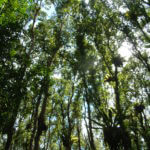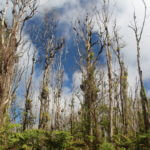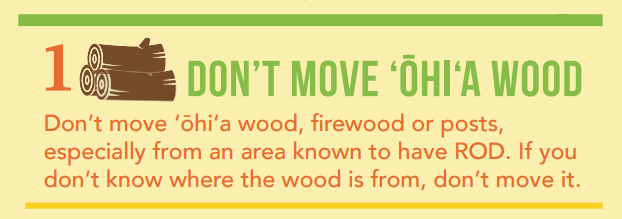Guest blog by Corie Yanger, Rapid ʻŌhiʻa Death (ROD) Educational Specialist, University of Hawaiʻi Extension
If you were to ask biologists and cultural practitioners in Hawaiʻi what the most important tree is in the state, “ʻōhiʻa” would likely be the answer. Not only does ʻōhiʻa (pronounced oh-hee-yah, or oh-hee-uh) cover roughly 1 million acres across the Hawaiian Islands, it is one of the first flowering plants to establish on fresh lava flows, and a keystone species of native wet forests. Consequently, one of the largest threats to the health of Hawaiʻi’s native forest ecosystems would be a pest or disease that kills ʻōhiʻa. In the last several years, that threat has surfaced – Rapid ʻŌhiʻa Death (ROD).
ROD is a fungal disease that has killed hundreds of thousands of ʻōhiʻa trees and affected more than 50,000 acres of forest in Hawaiʻi. All confirmed cases of ROD-infected trees are located on the largest island, called Hawaiʻi Island or Big Island. Prior to infecting trees on Hawaiʻi, this disease was not known to the scientific community.
Before and after photos of affected ʻōhiʻa forest canopies, photo credits: J.B. Friday


The fungus enters a tree through a wound (such as a scraped area in the bark, or a cut limb), establishes within the sapwood (where the water-conducting cells are located), and eventually stops water flow within the tree. Months or even a year may pass before the tree shows outward symptoms. ROD causes green leaves of entire trees to turn yellow, then brown, in just a few days to several weeks. This rapid progression is how the disease got its name, Rapid ʻŌhiʻa Death.
Researchers recently discovered that the disease symptoms people see are actually caused by two different introduced species of fungus in the genus Ceratocystis. The species cause slightly different symptoms, but the differences are too subtle to tell apart in the field. The species are genetically unique from any other fungal species ever found associated with ʻōhiʻa, and will soon receive their own new species names.
In Hawaiʻi, ʻōhiʻa gather the rain that recharges our island aquifers. In that same way, ʻōhiʻa have also gathered scientists, managers, educators, cultural practitioners, and many more groups together to combat Rapid ʻŌhiʻa Death. A large partnership of non-governmental and governmental organizations formed a ROD Working Group in 2015 to coordinate research, management, and outreach. This working group has facilitated important advances in our understanding and tracking of ROD, through aerial surveys and field detection, mapping suspect ROD-affected trees and areas, and identifying the potential vectors that most likely spread the disease.
The ROD working group has also assisted the Hawaiʻi Department of Agriculture by providing science-based support for a quarantine rule restricting movement of ʻōhiʻa material and soil off of Hawaiʻi Island- including the movement of ʻōhiʻa firewood and posts. A statewide ROD prevention program reaches thousands of Hawaiʻi’s residents and visitors every day through printed media, radio, internet, community talks, school presentations, landowner visits, and informational tables.
Excerpted image from “5 Things You Can Do To Reduce the Spread of ROD rack card”

Researchers do have hope despite the severity of the ROD situation. ʻŌhiʻa is a highly variable genus with eight named varieties of Metrosideros polymorpha and four other species of Metrosideros found on older Hawaiian Islands. With such high genetic diversity ROD researchers are testing the different varieties and species to see if disease resistance exists naturally. Another area of hope lies in observations of heavily impacted forests. Where ROD-related ʻōhiʻa tree loss has been the worst, meaning 75% or greater, researchers still see living, apparently healthy trees. Future studies will test cuttings from those healthy individuals to see if the trees are resistant to ROD.



